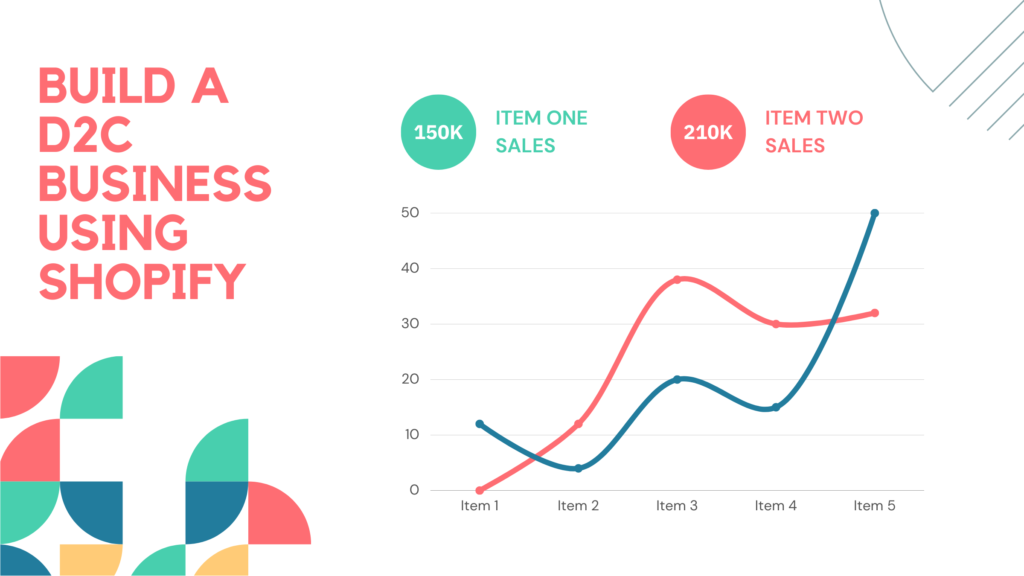Build a D2C Business Using Shopify. As digitalization spreads to more of our lives and the Internet Generation proliferates, consumers and the way they shop have changed drastically. Commerce is taking a sharp left away from resale and physical-only retail, and towards online, direct purchases from choice, through D2C.

I. What is D2C Business?
A game-changing way to build your brand, direct-to-consumer (D2C) is a newer business model where you directly manage production, packing, distribution, and shipping. This allows brands to do away with middlemen like resellers and so transact and interact more closely with their customers.
So, what makes D2C so popular among brands, online and traditional, dropshipping and original wholesale, and in various industries? And why should you consider adopting the D2C model?
-
Greater Profit and Price Control
With the removal of middlemen from the end-to-end process, brands get to reduce overhead costs at each stage and hence maximize profit margins without significant changes to price and product quality. This means that you’ll get more financial bandwidth to set prices for their products, including price reductions and sales to boost competitiveness and attract new customers, as well as higher prices for improved or newly launched products.
-
Tighter Customer Feedback Loops and Better Product Testing
The nature of D2C offers you a slew of new opportunities, with direct customer communication tightening feedback loops at each stage of production. This includes social media polls during testing and after-sales service and feedback, all instrumental in raising brand awareness and building customer satisfaction and loyalty. The greater degree of communication in a D2C model allows you to undergo more efficient product testing and improvements, as you can effectively just ask customers what they want. In a D2C model, you can leverage tighter customer feedback loops and better product testing to refine even the smallest details, such as the design and quality of your business cards.
-
Personalized Customer Experiences
Another benefit of D2C’s closeness to customers is the opportunity for you to also offer and work with customers on more personalized goods and services. These are especially suitable for small to medium businesses that make-to-order, but works for almost all businesses to distinguish brand identity and products; a must in highly saturated markets like fashion.
The D2C model is flexible and can work for any business, across platforms and industries.
II. D2C Business in eCommerce
If you’re based largely online and transacting through eCommerce, D2C can help fine-tune and improve existing processes for greater efficiency and cost savings. With greater control over their digital storefront, brands using the D2C model can customize their business platform to suit customer needs, such as by including popular payment methods in various countries. With D2C, brands can also better coordinate social media marketing with product development and sales, for example, live-streaming demonstrations of new products as they launch in real-time.

For ordering and delivery, D2C gives brands the edge by providing options for online ordering and delivery for greater customer convenience and thus satisfaction.
With the close coordination between each stage of the process under the D2C model, brands are better positioned to compete with digitally native consumers, especially in saturated markets and those which have already transitioned into eCommerce. This is especially suited to small and medium brands which start out with relatively less online presence, and need to carve out a niche identity and loyal customer base to thrive.
III. D2C Business in Traditional Retail
Just because D2C works with digital-native brands, that doesn’t mean that traditional retailers have to be left in the dust! D2C can work for your brick-and-mortar as well, supporting the adoption of an online platform to complement the advantage of a physical store.
Similar to D2C for online brands, the business model offers the option to customize a traditional brand’s online presence to complement rather than completely replace its established physical presence. Traditional brands can set up a digital storefront focusing on attracting new, non-local customers, such as by adding online ordering and delivery customers to expand the customer base beyond the local area.
Brands can also further improve services and attract more local customers by coordinating online and offline business, such as by including local pickup options for online orders, or even early reservations of yet-to-be-launched products.
IV. Build a D2C Business Using Shopify
And if a complete, absolute move into the D2C model where you and your brand have greater control but also much greater responsibility for every aspect of the business is intimidating, never fear, Shopify eCommerce is here! Whether yours is an original production of goods or a dropshipping business model, the work of building and maintaining an online sales platform can be challenging. Luckily, Shopify makes this a seamless and simple process.

Shopify direct-to-consumer brands include well-established major players like Nescafé and Kraft Heinz as well as up-and-coming young brands like Chubbies. If yours is a brand looking to adopt a D2C by-feature instead of wholesale can begin by offloading the brunt of transaction and online platform work to Shopify.
This is especially applicable to dropshipping business models, wherein inventory and order management are similarly outsourced, and you can then focus on the building and marketing of your brand’s identity. With the platform’s many options for customization, you don’t have to worry about losing D2C’s unique proposition of tailoring your platforms to your needs.
For example, Shopify direct-to-consumer includes a multitude of themes, free and paid, so regardless of how specific a theme and look you’re going for, you’ll still have options. Whether you’re looking to follow in the footsteps of brands successfully adopting D2C with clean aesthetics or targeting the search engine, Shopify’s got you covered.
And if you’re sold on D2C and adopting features of the model through Shopify direct-to-consumer, that brings us to the next big question: How?
V. Setting Up a D2C Business on Shopify
With the saturation of eCommerce and the massive amounts of content online, it’s tough for a brand, especially a younger, fresh-to-the-market one, to stand out and grab customer attention. So, it’s absolutely essential that you nail your entry into Shopify eCommerce from the get-go, be it customers’ first impressions of your site to their first purchase. The process of making this a reality is easier said than done, but not impossible with good planning!
Plan and Grow Your Business
Before you get into the actual set-up of your Shopify direct-to-consumer brand and business, it’s important to do a thorough and honest assessment of your brand’s needs, goals, and available resources.
This includes a review of current problems with your business if you’re expanding into Shopify direct-to-consumer from traditional retail, like decreasing foot traffic or changing consumer preferences. This helps you identify the main “problems” your brand faces and so set up your extension to solve these problems.

For example, if your brick-and-mortar is experiencing decreased physical sales from lower foot traffic, you can direct your online extension towards increasing your customer base and gaining online presence through online offers and deals with local pick-up options, increasing sales and familiarizing new customers with your physical location, which may lead to a return, in-person purchases.
Regarding goals, do note that most if not all businesses have similar objectives like “expand customer base” and “increase brand presence”. Use clear metrics, such as the views and follower or subscriber counts on your social media extensions. This will allow you to clearly track progress and make adjustments and changes immediately where needed.
And as for resources, take a minute to inspect each part of your supply chain and delivery process to make sure that your brand’s overall logistics set-up can handle a potential increase in orders as well as new processes involved in personalization, online delivery, and more. This ensures that after you open your Shopify direct-to-consumer extension with a bang, your production and delivery process can keep up with the hype and follow through with the high expectations set by your new, digital customers.
VI. Conclusion: Go the Distance with Koala Inspector
In summary, the D2C model is a promising opportunity for brands looking to take back control of every aspect of their business and connect more closely with those who matter most: the customers. While this is extremely welcome in the very personal areas of product development, from concept to A/B testing to after-sales feedback, other aspects of the business like the set-up of websites, sales platforms, and payment options are a little more challenging.
That’s where a reliable, customizable platform like Shopify comes in! Shopify’s many options for tailoring personal elements of an online store, from theme to store blog to promotions, come with full support for various payment options from Shop Pay to cards to invoices and even cryptocurrency.
And with the success of Shopify’s direct-to-consumer brands and businesses comes competition. But you can still make use of the many features of Shopify without worrying about all the other players when you’ve got Koala Apps.
Koala Apps is your one-stop-shop for access to market data, even those specific to your closest Shopify competitors. With Koala Apps’ Koala Inspector, you’ll have all the information you need on competitive aspects of business, from price points to themes to even ad campaigns. Get your hands on what you need to know to adjust and best position your brand for D2C success on Shopify!







